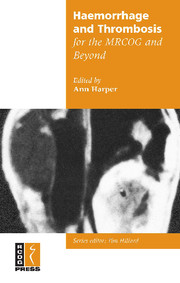Book contents
- Frontmatter
- Contents
- About the authors
- Abbreviations
- Preface
- 1 The coagulation system in pregnancy
- 2 Pregnancy in women with inherited bleeding disorders
- 3 Maternal and fetal thrombocytopenia
- 4 Massive obstetric haemorrhage
- 5 Disseminated intravascular coagulation
- 6 Gynaecological problems in women with bleeding disorders
- 7 Venous thromboembolism in obstetrics and gynaecology
- 8 Genetic thrombophilias and antiphospholipid antibodies
- Index
8 - Genetic thrombophilias and antiphospholipid antibodies
Published online by Cambridge University Press: 05 October 2014
- Frontmatter
- Contents
- About the authors
- Abbreviations
- Preface
- 1 The coagulation system in pregnancy
- 2 Pregnancy in women with inherited bleeding disorders
- 3 Maternal and fetal thrombocytopenia
- 4 Massive obstetric haemorrhage
- 5 Disseminated intravascular coagulation
- 6 Gynaecological problems in women with bleeding disorders
- 7 Venous thromboembolism in obstetrics and gynaecology
- 8 Genetic thrombophilias and antiphospholipid antibodies
- Index
Summary
The term ‘thrombophilia’ defines situations associated with an increased risk of venous thromboembolism (VTE) characterised by hyper-coagulability. Normal haemostasis requires the maintenance of a balance between the procoagulant system, which provides protection from bleeding after vascular injury, and the anticoagulant system, which protects against the effects of excessive coagulation (see Chapter 1). Overactivity in procoagulant factors or underactivity in anticoagulant factors may upset this balance, resulting in a predisposition to VTE. Changes in the circulating levels of pro- and anticoagulant proteins, venous blood flow and the vascular endothelium all contribute to the hypercoaguable state associated with normal pregnancy. Some individuals also have a genetic or acquired thrombophilia. Thrombosis and thrombophilia have been implicated in the pathophysiology of a number of obstetric complications including recurrent miscarriage, intrauterine growth restriction, placental abruption and pre-eclampsia.
Molecular risk factors for VTE may be genetic or phenotypic. Genetic factors comprise all mutations responsible for a loss or gain of function that predispose to VTE such as deficiencies of the naturally occurring anticoagulants and genetic mutations of factor V and prothrombin. Phenotypic factors are abnormalities in laboratory tests that are associated with VTE and may have both genetic and environmental influences.
Exploration of the pathogenesis of VTE has produced a multifactorial model of disease that depends on variable combinations of acquired and genetic risk factors (Table 8.1). Familial clustering of cases illustrates the genetic component, while the episodic nature of events implicates an acquired or environmental influence.
Keywords
- Type
- Chapter
- Information
- Haemorrhage and Thrombosis for the MRCOG and Beyond , pp. 111 - 127Publisher: Cambridge University PressPrint publication year: 2005



